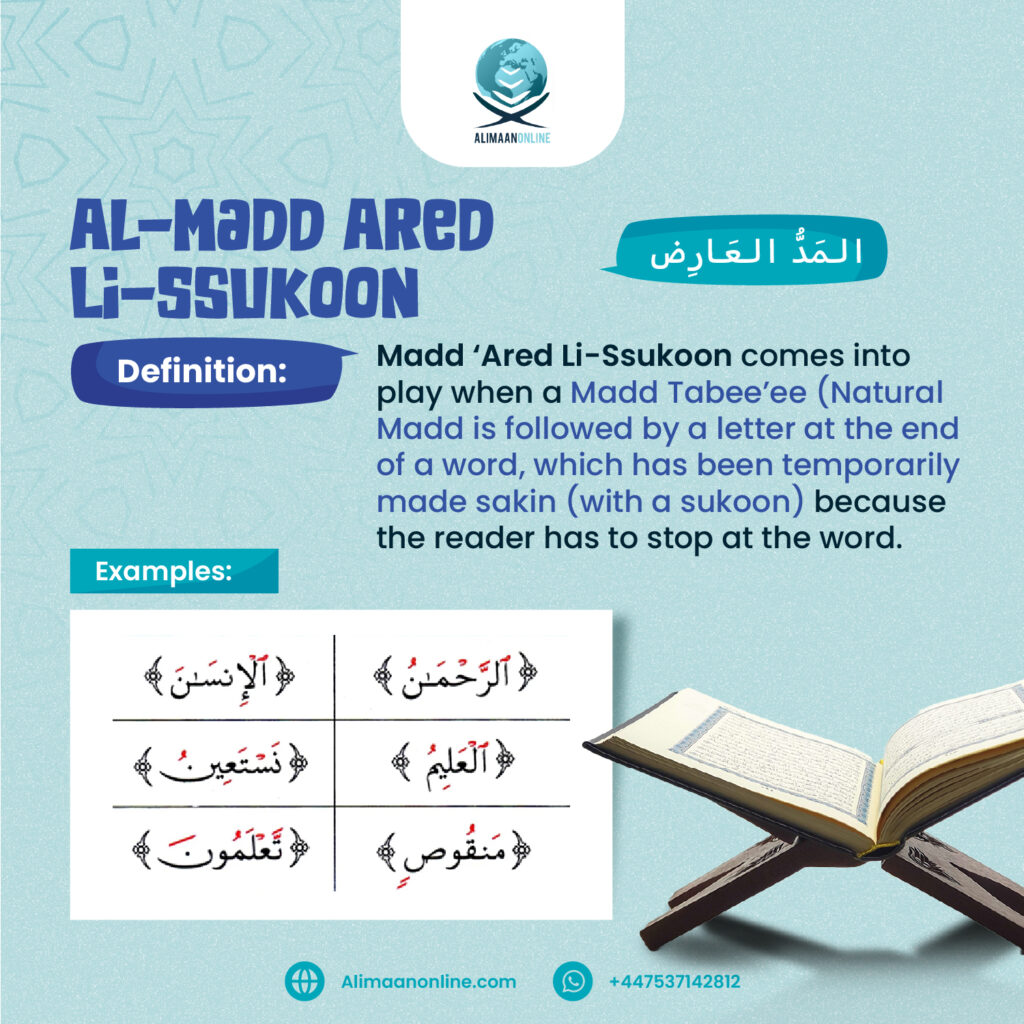Al-Madd Al-Aarid Li Ssukoon is a significant aspect of Tajweed, the art of Quranic recitation. Consequently, it plays a vital role in ensuring proper pronunciation and rhythm in the recitation of the Quran. Therefore, understanding Al-Madd Al-Aarid Li Ssukoon and its principles is essential for anyone who aims to recite the Quran accurately and beautifully.
What is Madd Arid Lissukun?
Al-Madd Al-Aarid Li Ssukoon, also known as Madd Arid Lissukun, is one of the categories of Madd (elongation) in Tajweed.
Madd ‘Ared Li-Ssukoon, a type of Madd, earns its characterization as “temporary Madd for stopping” in Tajweed. This rule comes into play when a Madd Tabee’ee (Natural Madd) in the letters ا (Alif), و (Waw), or ي (Ya) is followed by a letter at the end of a word, which has been temporarily made sakin (with a sukoon) because the reader has to stop at the word. In such cases, the reader should prolong the Madd Tabee’ee to become Madd ‘Ared Li Ssukoon.
Madd ‘Ared Li-Ssukoon is prolonged for 2, 4, or 6 beats. It’s important to note that Madd ‘Ared Li-Ssukoon only applies if the reader stops at that word. If the reader doesn’t stop, it should be considered as a Madd Tabee’ee (Natural Madd) lasting 2 beats.
Understanding Madd Arid Lissukun is crucial for proper Quranic recitation as it helps maintain the intended melody and rhythm, ensuring that the words of Allah are recited with the respect and precision they deserve.
The Principles of Madd Arid Lissukun
The principles of Al-Madd Al-Aarid Li Ssukoon are based on specific rules that govern its application. These principles ensure consistency and correctness in recitation.
Identification of Madd Arid Lissukun
To correctly identify Madd Arid Lissukun, one must look for the following signs:
1. A long vowel (madd) appears at the end of a word.
2. The next word begins with a consonant that has a sukoon.
Duration of Elongation
The elongation of Madd Arid Lissukun can vary:
– Two counts (harakat): This is the shortest elongation.
– Four counts (harakat): This is a moderate elongation.
– Six counts (harakat): This is the longest elongation.
The choice of elongation often depends on the style of recitation (Qira’at) being followed.
Application in Different Qira’at
Different Qira’at (methods of recitation) may have slight variations in the application of Madd Arid Lissukun. It is important for a reciter to be aware of the specific rules of the Qira’at they are following to ensure correct recitation.
Significance in Quranic Recitation
The significance of Al-Madd Al-Aarid Li Ssukoon in Quranic recitation cannot be overstated. This rule enhances the melodic flow and rhythm of the recitation, making it more pleasing to the ear. Additionally, it ensures that the recitation is done in a manner that reflects the divine nature of the Quran.
Enhancing the Melody of Recitation
By applying the rules of Madd Arid Lissukun, a reciter can add a melodious quality to their recitation. Moreover, the varying lengths of elongation allow for a rhythmic and musical flow, which is integral to the beauty of Quranic recitation.
Reflecting on the Divine Nature of the Quran
Proper application of Tajweed rules, including Madd Arid Lissukun, is a way of honoring the divine words of the Quran. Furthermore, it shows respect and reverence for the sacred text, thereby ensuring that it is recited as it was revealed to the Prophet Muhammad (peace be upon him).
Examples of Madd Arid Lissukun in the Quran
To better understand Al-Madd Al-Aarid Li Ssukoon, let us look at some examples from the Quran. These examples illustrate how the rule is applied in different contexts.
Surah Al-Fatiha, Ayah 1
In the first verse of Surah Al-Fatiha, we see an example of Madd Arid Lissukun:
“بِسْمِ اللَّهِ الرَّحْمَنِ الرَّحِيمِ”
Here, the word “الرَّحِيمِ” ends with a long vowel (Ya) followed by a consonant with a sukoon, demonstrating the rule of Madd Arid Lissukun.
Surah Al-Baqarah, Ayah 5
Another example can be found in Surah Al-Baqarah, verse 5:
“أُو۟لَٰٓئِكَ عَلَىٰ هُدًۭى مِّن رَّبِّهِمْ ۖ وَأُو۟لَٰٓئِكَ هُمُ ٱلْمُفْلِحُونَ”
In this verse, the word “هُدًۭى” ends with a long vowel followed by a consonant with a sukoon, applying the Madd Arid Lissukun rule.
Surah Al-Fatiha, Ayah 4
In the fourth verse of Surah Al-Fatiha, we see an example of Madd Arid Lissukun:
“مَالِكِ يَوْمِ الدِّينِ”
In this verse, the word “الدِّينِ” is often followed by a natural pause, especially during slow recitation or when concluding the verse. When reciting “الدِّينِ” and stopping at it, Madd Arid Lissukun is applied to the last letter “نِ”. Stopping here would invoke an elongation of 2-6 harakat, making the recitation more melodious and emphatic.
Surah Al-Ikhlas, Ayah 3
Another example can be found in Surah Al-Ikhlas, verse 3:
“إِلَـٰهِ ٱلنَّاسِ”
In this verse, the final word “ٱلنَّاسِ” (‘mankind’) is often elongated due to Madd Arid Lissukun. Upon reaching “ٱلنَّاسِ” and pausing, the reciter elongates the last two letters “اسِ”. The elongation of “ٱلنَّاسِ” due to Madd Arid Lissukun adds a profound sense of finality and emphasis, stretching for 2-6 harakat depending on the reciter’s style and the contextual requirements of the recitation.
Comparative Analysis with Other Madd Rules
Al-Madd Al-Aarid Li Ssukoon is just one type of Madd in the rules of Tajweed. It is important to compare it with other Madd rules to understand its unique characteristics and application.
Learn more: Madd rules
Comparison with Madd Asli
Madd Asli, also known as natural elongation, is the simplest form of Madd. It involves a straightforward elongation of two counts and does not involve any specific conditions like a following sukoon. In contrast, Madd Arid Lissukun involves a vowel followed by a sukoon and allows for varying lengths of elongation.
Learn more: Madd Tabee’ee
Comparison with Madd Badal
Madd Badal occurs when a Hamza (glottal stop) is followed by a long vowel. Unlike Madd Arid Lissukun, Madd Badal does not involve a sukoon and has a fixed elongation of two counts. Madd Arid Lissukun, on the other hand, involves elongation due to the presence of a sukoon and can vary in length.
Comparison with Madd Lazim
Madd Lazim, or necessary elongation, requires a fixed elongation of six counts and occurs in specific circumstances, such as when a vowel is followed by a shaddah (doubled consonant). Madd Arid Lissukun differs in that it does not require a fixed elongation and depends on the presence of a sukoon.
Conclusion:
Al-Madd Al-Aarid Li Ssukoon is an essential rule in the art of Quranic recitation, ensuring that the words of Allah are recited with the appropriate rhythm and melody. Consequently, by understanding its principles and significance, reciters can enhance their recitation and, thereby, honor the divine text. Whether you are a beginner or an experienced reciter, mastering Madd Arid Lissukun is a step towards achieving proficiency in Tajweed.

